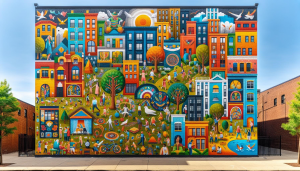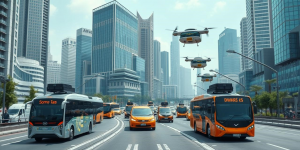Okay, let’s face it: our cities are in trouble. Overheating, polluted, and feeling more disconnected than ever. But there’s a secret weapon we often overlook: urban green spaces. We’re talking parks, gardens, green roofs – even those humble street trees. They’re not just window dressing; they’re vital to a city’s health. As an urban designer, I’ve seen firsthand how a little greenery can transform a place.
Why Go Green? The Astonishing Benefits of Urban Nature
So, what’s the big deal about green spaces? Simple: they deliver a ton of benefits. Let’s break it down.
Nature’s Environmental All-Stars
First up: air quality. Trees are like natural air filters, gobbling up pollutants like nitrogen dioxide and those nasty particulate matters.

Even better, they’re carbon sequestration champions, sucking CO2 out of the atmosphere and locking it away. This is huge in the climate change battle. Oh, and they give us oxygen, you know, the stuff we need to breathe.
And then there’s the urban heat island effect. Cities get way hotter than the surrounding countryside because of all that concrete and asphalt. Green spaces, with their shade and plant-powered cooling (evapotranspiration, if you want to get technical), help bring the temperature down. This makes city life more bearable and saves energy on air conditioning.
Let’s not forget stormwater management. Paved surfaces send rainwater rushing into drains, causing floods. Green spaces act like sponges, soaking up the water and easing the pressure on our systems. Plus, they help replenish groundwater.
Finally, biodiversity. Cities can actually be surprisingly wildlife-rich, and green spaces provide vital habitats for birds, bugs, and all sorts of creatures. Connecting these spaces with green corridors makes ecosystems more resilient.
Beyond the Scenery: Social and Economic Perks
Green spaces aren’t just about the environment; they also boost our well-being in a big way.
Think about how you feel in nature. Relaxed? Calmer? Studies show that access to green spaces reduces stress, anxiety, and depression, leading to better mental health. It’s not just a feeling; it’s science.
They also get us moving! Parks and trails offer opportunities for exercise, which is crucial in our often-sedentary city lives.
Plus, green spaces bring people together. Parks and community gardens become hubs for interaction and relationship-building. This is especially important for marginalized communities.
Believe it or not, greenery can even increase property values and spur economic growth. Homes near parks are more desirable, and businesses near green spaces often attract more customers. A well-kept park is a real asset.
Green Space Strategies: How to Make it Happen
So, we know green spaces are awesome. But how do we create them in our packed cities? It’s a challenge, but definitely doable.
Strategic Thinking: It’s More Than Just Planting
The first step is a comprehensive green space plan, woven into the city’s overall urban strategy and designed to meet everyone’s needs. It’s not enough to just plop down a few parks; we need to think strategically about how green spaces can tackle specific problems like pollution, flooding, or social isolation.
Connectivity is key. Green spaces should link up, creating a network of green corridors for people and wildlife. Think green streets, trails, and even green roofs.
Community input is also essential. Green spaces should be designed with the help of local residents to ensure they’re useful and loved. Public meetings, surveys, and workshops are great ways to get people involved. When communities feel ownership, they’re much more likely to use and care for their green spaces.
Retrofitting Green: Finding Opportunities Everywhere
We need to get creative and find green space opportunities in unexpected places.
Green roofs, for example, can transform underused rooftops into valuable green areas. Vertical gardens can add life to building walls. And even tiny pocket parks can make a big difference in dense neighborhoods.
Don’t underestimate street trees. They provide shade, improve air quality, and beautify neighborhoods. Just choose the right species for the local climate and soil.
Funding the Dream: Making Green a Priority
Creating and maintaining green spaces costs money. Cities need to allocate enough resources for planning, design, construction, and upkeep. This can be done through property taxes, development fees, and partnerships between public and private entities.
We should also explore new funding models like green bonds and environmental impact bonds, which can attract private investment in green projects.
Green Space Success Stories: Cities That Get It
Let’s look at some cities that are leading the way:
- Singapore: Known as a “city in a garden,” Singapore has deliberately integrated green spaces throughout its urban environment, with a huge network of parks, gardens, and green roofs.
- Copenhagen: This Danish capital has long been a leader in sustainable urban planning, investing heavily in green infrastructure and promoting cycling and walking.
- Medellín: This Colombian city has transformed itself through innovative urban planning, creating parks and green spaces in its poorest neighborhoods to improve residents’ lives.
A Green Future: A Call to Action
Urban green spaces aren’t a luxury; they’re a necessity for healthy, sustainable, and livable cities. As planners, policymakers, and community leaders, we need to prioritize them.
Let’s work together to create cities that are vibrant, green oases where people and nature thrive. The future depends on it.
So, get involved! Plant a tree, support your local park, and let’s build a greener future together.
Frequently Asked Questions
- Q: What percentage of a city should be green space?
A: There’s no perfect number, but many experts suggest aiming for at least 30-40%. The ideal target depends on the city’s specific characteristics.
- Q: How can I help green my community?
A: Volunteer at a local park, join a community garden, or advocate for more green spaces in your neighborhood. Contact your local government or environmental organizations for more information.
- Q: What are the challenges of creating urban green spaces?
A: Limited space, high land costs, and competing priorities can be challenging. However, creative planning and design can overcome these obstacles.


